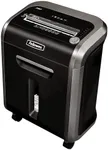Buying Guide for the Best Fellowes Shredders
Choosing the right paper shredder is all about matching your needs with the shredder’s capabilities. Whether you’re looking to protect sensitive information at home or need a heavy-duty machine for the office, understanding the key features will help you make a smart choice. Think about how much you’ll shred, what types of materials you’ll be destroying, and how often you’ll use the shredder. This will guide you to a model that’s efficient, secure, and reliable for your situation.Shred Type (Cut Style)Shred type refers to the way a shredder cuts paper. The main types are strip-cut, cross-cut, and micro-cut. Strip-cut shredders slice paper into long strips and offer basic security, suitable for non-sensitive documents. Cross-cut shredders chop paper into small pieces, providing a higher level of security for personal or confidential information. Micro-cut shredders turn paper into tiny particles, offering the highest security, ideal for highly sensitive documents. To choose the right one, consider how confidential your documents are: the more sensitive, the finer the cut you should select.
Sheet CapacitySheet capacity tells you how many sheets of paper the shredder can handle at once. Lower capacity models may shred 5-8 sheets per pass, which is fine for occasional home use. Medium capacity shredders can handle 10-15 sheets, suitable for small offices or frequent use. High capacity models can shred 16 or more sheets at a time, ideal for busy offices with lots of paperwork. Think about how much you typically shred in one go—if you often have stacks of paper, a higher sheet capacity will save you time.
Run Time and Cool Down TimeRun time is how long a shredder can operate before it needs to cool down, while cool down time is how long it takes before you can use it again. Light-duty shredders may run for a few minutes before needing a break, which is fine for occasional use. More robust models can run for 10-30 minutes or even continuously, which is better for heavy or shared use. If you plan to shred large volumes at once, look for a longer run time and shorter cool down period to avoid interruptions.
Bin CapacityBin capacity is the size of the waste container that collects shredded paper. Smaller bins (around 3-5 gallons) are suitable for light use and need to be emptied more often. Medium bins (6-10 gallons) are good for regular use in a home office or small business. Large bins (over 10 gallons) are best for high-volume shredding in busy environments. Choose a bin size that matches how much you shred and how often you want to empty it.
Safety FeaturesSafety features help prevent accidents, especially if you have children or pets around. Common features include safety locks, automatic shut-off if hands are detected near the opening, and jam-proof systems. If safety is a concern in your environment, look for models with enhanced safety features to give you peace of mind.
Noise LevelNoise level indicates how loud the shredder is during operation. Quieter models are better for shared spaces or home offices where noise can be disruptive. If you’ll be shredding in a quiet environment, look for a shredder with a low decibel rating or one that’s marketed as quiet.
Ability to Shred Other MaterialsSome shredders can handle more than just paper, such as credit cards, CDs, or staples. If you need to destroy these types of items, make sure the shredder you choose is rated for them. This adds versatility and convenience, especially for office use.

















